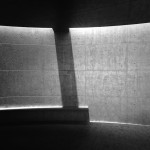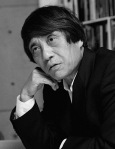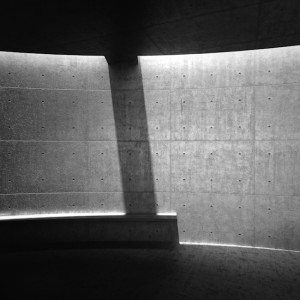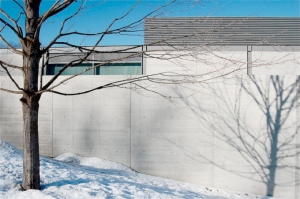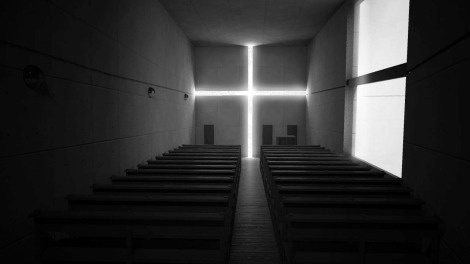
TOWARD NEW HORIZONS IN ARCHITECTURE, TADAO ANDO
“Toward New Horizons in Architecture,” Tadao Ando, 1991
Architectural thought is supported by abstract logic. By abstract I mean to signify a meditative exploration that arrives at a crystallization of the complexity and richness of the world, rather than a reduction of its reality through diminishing its concreteness.
Postmodernism emerged in the recent past to denounce the poverty of modernism at a time when that movement was deteriorating, becoming conventionalized, and had abandoned its self-ordained role as a revitalizing cultural force. Modernist architecture had become mechanical, and postmodernist styles endeavored to recover the formal richness that modernism appeared to have discarded. This endeavor undeniably was a step in the right direction – utilizing history, taste, and ornament-and restored to architecture a certain concreteness. Yet this movement, too, has quickly become mired in hackneyed expression, producing a flood of formalistic play that is only confusing rather than inspiring.
The most promising path open to contemporary architecture is that of a development through and beyond modernism. This means replacing the mechanical, lethargic, and mediocre methods to which modernism has succumbed with the kind of abstract, meditative vitality that marked its beginnings, and creating something thought-provoking that will carry our age forward into the twenty-first century. The creation of an architecture able to breathe new vigor into the human spirit should clear a road through the present architectural impasse.
Transparent Logic
Architectural creation involves contemplating the origins and essence of a project’s functional requirements and the subsequent determination of its essential issues. Only in this way can the architect manifest in the architecture the character of its origins.
In envisioning the Chikatsu-Asuka Historical Museum, Osaka, on a site central to early Japanese history, I came to realize the vital importance of establishing an architecture that didn’t mar the grandeur of the existing landscape. Therefore, I focused on architecture’s power to produce a new landscape, and sought to create a museum that would embrace the entire landscape within the scope of its exhibitions.
In contemporary society, architecture is determined by economic factors and for the most part ruled by standardization and mediocrity. The serious designer must question even the given requirements, and devote deep thought to what is truly being sought. This kind of inquiry will reveal the special character latent in a commission and cast sharp light on the vital role of an intrinsic logic, which can bring the architecture to realization. When logic pervades the design process the result is clarity of structure, or spatial order – apparent not only to perception, but also to reason. A transparent logic that permeates the whole transcends surface beauty, or mere geometry, with its intrinsic importance.
Abstraction
The real world is complex and contradictory. At the core of architectural creation is the transformation of the concreteness of the real through transparent logic into spatial order. This is not an eliminative abstraction but, rather, an attempt at the organization of the real around an intrinsic viewpoint to give it order through abstract power. The starting point of an architectural problem – whether place, nature, lifestyle, or history – is expressed within this development into the abstract. Only an effort of this nature will produce a rich and variable architecture.
In designing a residence – a vessel for human dwelling – I pursue precisely that vital union of abstract geometrical form and daily human activity.
In the Row House (Azuma Residence), Suniyoshi, I took one of three wood row houses and reconstructed it as a concrete enclosure, attempting to generate a microcosm within it. The house is divided into three sections, the middle section being a courtyard open to the sky. This courtyard is an exterior that fills the interior, and its spatial movement is reversed and discontinuous. A simple geometric form, the concrete box is static; yet as nature participates within it, and as it is activated by human life, its abstract existence achieves vibrancy in its meeting with concreteness. In this house my chief concern was the degree of austerity of geometric form that could be fused with human life. This concern predominates in my Koshino House, Kidosaki House, in other residential works, and in other types of buildings as well. Geometric abstraction collides with human concreteness, and then the apparent contradiction dissolves around their incongruity. The architecture created at that moment is filled with a space that provokes and inspires.
Nature
I seek to instill the presence of nature within an architecture austerely constructed by means of transparent logic. The elements of nature – water, wind, light, and sky – bring architecture derived from ideological thought down to the ground level of reality and awaken manmade life within it.
The Japanese tradition embraces a different sensibility about nature than that found in the West. Human life is not intended to oppose nature and endeavor to control it, but rather to draw nature into an intimate association in order to find union with it. One can go so far as to say that, in Japan, all forms of spiritual exercise are traditionally carried out within the context of the human interrelationship with nature.
This kind of sensibility has formed a culture that de-emphasizes the physical boundary between residence and surrounding nature and establishes instead a spiritual threshold. While screening man’s dwelling from nature, it attempts to draw nature inside. There is no clear demarcation between outside and inside, but rather their mutual permeation. Today, unfortunately, nature has lost much of its former abundance, just as we have enfeebled our ability to perceive nature. Contemporary architecture, thus, has a role to play in providing people with architectural places that make them feel the presence of nature. When it does this, architecture transforms nature through abstraction, changing its meaning. When water, wind, light, rain, and other elements of nature are abstracted within architecture, the architecture becomes a place where people and nature confront each other under a sustained sense of tension. I believe it is this feeling of tension that will awaken the spiritual sensibilities latent in contemporary humanity.
At the Children’s Museum, Hyogo, I have arranged each of the architectural elements to allow congenial meetings with water, forest, and sky under ideal conditions. When the presence of architecture transforms a place with a new intensity, the discovery of a new relationship with nature is possible.
Place
The presence of architecture – regardless of its self-contained character – inevitably creates a new landscape. This implies the necessity of discovering the architecture which the site itself is seeking.
The Time’s Building, situated on the Takase River in Kyoto, originated out of the involvement with the delicate current of the nearby river. The building’s plaza where one can dip a hand in the water, the bridge like attitude of its deck above the current, the horizontal plan of approach from along the river rather than from a road – these elements serve to derive the utmost life from the character of the building’s unique setting. The Rokko Housing project was born from attention to an equally singular site, in this case one pitched on a maximum sixty-degree slope. Underlying its design was the idea of sinking the building in along the slope, governing its projection above the ground in order to merge it into the surrounding cover of dense forest. This affords each dwelling unit an optimal view of the ocean from a terrace provided by its neighbor’s roof. (the essence of the site=the experience of viewing the sweeping vista of the sea from powerful gesture of the mountain, framed by the dense cover of trees) Each of my projects, whether the Children’s Museum, Hyogo, the Forest of Tombs Museum, Kumamoto, the Raika Headquarters Building, or Festival, Okinawa, results from an endeavor to create a landscape by bringing the character of place fully into play.
I compose the architecture by seeking an essential logic inherent in the place. The architectural pursuit implies a responsibility to find and draw out a site’s formal characteristics, along with its cultural traditions, climate, and natural environmental features, the city structure that forms its backdrop, and the living patterns and age-old customs that people will carry into the future. Without sentimentality, I aspire to transform place through architecture to the level of the abstract and universal. Only in this way can architecture repudiate the realm of industrial technology to become “grand art” in its truest sense.

